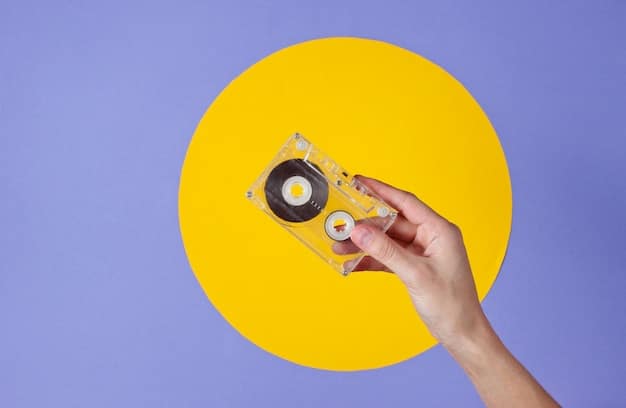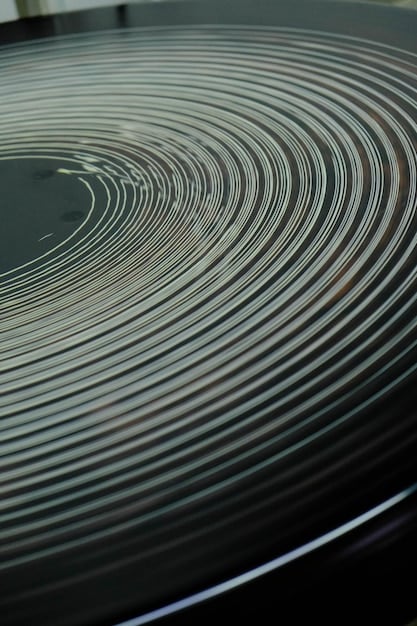Vinyl’s Comeback: Why Underground Artists Press Records in 2025

The continued relevance of vinyl records for underground artists in 2025 is driven by a unique blend of tangible appeal, superior sound quality, direct artist-fan connection, and a robust subculture that prioritizes physical media over ephemeral digital streams, ensuring its enduring presence despite technological advancements.
The Evolution of Vinyl: Why Underground Artists Are Still Pressing Records in 2025 is a phenomenon defying fleeting digital trends. In a landscape dominated by streaming, the tactile allure and rich sound of vinyl persist as a vital medium for those pushing musical boundaries. This article explores the multifaceted reasons behind vinyl’s unwavering appeal to underground artists, examining its cultural significance, economic viability, and profound impact on the artist-fan relationship in the modern era.
The Enduring Appeal of Tangibility in a Digital Age
In an increasingly digitized world, the physical presence of a vinyl record offers a profound counterpoint to the ephemeral nature of digital files. For both artists and fans, holding an album, studying its artwork, and engaging with its physical form creates a sensory experience that streaming simply cannot replicate. This tangible connection is a cornerstone of vinyl’s continued relevance, particularly within underground music circles where authenticity and immersion are highly valued.
The act of unboxing a newly acquired record, examining the sleeve notes, and carefully placing the needle on the groove transforms music consumption into a ritual. This ritual fosters a deeper, more intentional relationship with the art. It’s a stark contrast to the passive consumption often associated with endless playlists and algorithmic recommendations.
The Tactile Experience and Artistic Expression
Vinyl offers a canvas beyond just sound. The spaciousness of an LP sleeve provides ample room for elaborate artwork, detailed liner notes, and even hidden messages from the artist. This allows for a holistic artistic vision, where the visual and textual elements complement the audio, creating a richer narrative for the listener. Many artists see the vinyl format as an extension of their creative output.
- Visual Storytelling: Large artwork allows for complex designs that digital thumbnails cannot convey.
- Liner Notes & Lyrics: Space for detailed credits, lyrics, and conceptual explanations, deepening listener understanding.
- Exclusivity & Collectibility: Limited pressings and unique packaging enhance the record’s value as a collector’s item.
This physical embodiment of music fosters a sense of ownership and permanence. Unlike a digital download that might get lost in a hard drive, a vinyl record exists as a solid object, a testament to the artist’s work and the listener’s appreciation. It becomes a cherished item, often displayed prominently, symbolizing one’s musical identity and dedication to the art form.
Moreover, the tangible nature of vinyl aids in discovery and retention. Browsing record racks, whether in a store or a personal collection, encourages slower, more deliberate exploration of music. This can lead to unexpected discoveries and a more thorough appreciation of an artist’s discography, preventing the “skip culture” prevalent in digital streaming environments.
The inherent limitations of the vinyl format also contribute to its artistic appeal. The need to sequence tracks for two sides, for example, often leads artists to think more intentionally about album flow and narrative arcs, resulting in a more cohesive and deliberate listening experience than a seemingly endless digital playlist might offer.
The Sonic Superiority and Auditory Fidelity
Beyond its physical allure, the sound quality of vinyl remains a compelling reason for its continued preference, especially among audiophiles and artists who prioritize nuanced soundscapes. While digital audio offers unparalleled convenience and consistency, many argue that vinyl provides a warmer, richer, and more authentic listening experience. This perception is rooted in both the technical characteristics of analogue reproduction and the psychological impact of the listening ritual.
The fundamental difference lies in the analogue nature of vinyl, which captures continuous sound waves as physical grooves on a disc. Digital audio, conversely, converts these waves into discrete data points. While digital mastering has advanced dramatically, some argue that the conversion process inherently loses certain subtleties present in the original analogue signal. The warmth often attributed to vinyl comes from the natural harmonics and slight imperfections inherent in the analogue medium.
Mastering for Vinyl: A Unique Art Form
Producing a high-quality vinyl record involves a specialized mastering process distinct from that for digital formats. Audio engineers meticulously prepare tracks to ensure they translate optimally to the grooves, which often involves subtle adjustments to dynamics, EQ, and stereo imaging. This bespoke mastering can result in a more dynamic and engaging sound profile, often emphasizing clarity and depth over sheer loudness.
- Dynamic Range: Vinyl can often preserve a wider dynamic range, leading to more impactful contrasts between loud and quiet passages.
- Warmth and Presence: The inherent characteristics of analogue playback contribute to a perceived warmth and ‘presence’ that many listeners find more engaging.
- Reduced Listening Fatigue: Some audiophiles report less listening fatigue with vinyl due to the absence of the harshness sometimes associated with highly compressed digital audio.
This dedication to the mastering process is appealing to underground artists who often push sonic boundaries. They see vinyl as the truest representation of their artistic intent, allowing the subtle textures and intricate layers of their compositions to shine through. For genres that thrive on atmospheric depth, complex instrumentation, or raw, unpolished energy, vinyl often provides the ideal medium for faithful reproduction.
However, it’s important to recognize that “superior sound” is partly subjective and heavily dependent on the quality of the playback system. A well-maintained turntable, a high-quality cartridge, and a decent amplifier are crucial for unlocking vinyl’s full potential. For many, the investment in such equipment is part of the commitment to a premium listening experience, reflecting a desire to engage with music at a deeper level than casual streaming allows.
Ultimately, the perceived sonic superiority of vinyl is a blend of technical fidelity, the unique characteristics imparted by analogue reproduction, and the psychological effect of a more engaged listening process. For artists and purists, it’s about delivering and experiencing music in its most uncompromised, authentic form.

Cultivating Direct Artist-Fan Connection and Community
In an age dominated by vast, automated digital platforms, the vinyl record serves as a powerful conduit for fostering genuine, reciprocal relationships between underground artists and their dedicated fanbase. This direct connection often transcends mere consumption, building a community around shared appreciation for physical art and supporting independent creators. For many artists navigating the complexities of the modern music industry, vinyl is not just a format; it’s a statement of independence and a tool for building lasting loyalty.
Buying a physical record directly from an artist, whether at a show, through their Bandcamp page, or at a local record store, is an act of tangible support. Unlike streaming, which offers minuscule per-stream royalties, the sale of a vinyl record provides artists with a much more substantial and immediate income stream. This financial directness empowers artists to continue creating, touring, and investing in their craft, fostering a healthier, more sustainable ecosystem for independent music.
The Vinyl Release as a Cultural Event
A new vinyl release often becomes a significant event within an artist’s community. These aren’t just product drops; they are moments of celebration, anticipation, and collective experience. Limited editions, unique color variants, and special packaging elements turn each release into a highly anticipated collectible, driving engagement and creating a sense of urgency among enthusiasts.
- Fan Interaction: Physical sales at shows allow for direct conversations, signings, and personal connections.
- Dedicated Support: Purchasing vinyl is seen as a more meaningful form of patronage than streaming.
- Community Building: Shared collecting interests and the “hunt” for rare records foster fan camaraderie.
Beyond the initial purchase, vinyl records often facilitate deeper dialogue. Fans discuss specific pressings, compare sound quality, and share their experiences with others. Record stores themselves often serve as community hubs, places where enthusiasts gather, discover new music, and connect with like-minded individuals. This vibrant subculture thrives on the tangible nature of vinyl, turning passive listening into an active, social pursuit. Artists actively participate in this dialogue, engaging with fans about their records, pressing plants, and the artistic choices behind their physical releases.
Furthermore, vinyl allows artists to bypass traditional gatekeepers and retain greater creative control. While streaming platforms dictate terms and presentation, artists have near-complete autonomy over their vinyl releases – from the master recording to the artwork, packaging, and distribution. This independence is particularly appealing to underground artists who value authenticity and artistic integrity above mainstream commercial viability.
The decision to press vinyl is often viewed by fans as a sign of an artist’s commitment to their craft and to their audience. It signals that the music is meant to be consumed in a deliberate, high-quality manner, rather than just as background noise. This mutual respect — the artist’s dedication to quality and the fan’s willingness to invest — solidifies the bond that defines the underground music scene.
Economic Viability and Sustainability for Independents
While the initial cost of pressing vinyl records can be substantial, particularly for smaller runs, the long-term economic viability and sustainability it offers to underground artists are surprisingly robust. In an industry where streaming royalties are notoriously low, vinyl provides a critical revenue stream that directly supports artists, allowing them to fund future projects, tours, and the often-expensive process of creating independent music. This financial independence is a key factor in vinyl’s continued resurgence.
For independent labels and self-releasing artists, vinyl records often command a premium price compared to digital downloads or CDs. Fans are willing to pay more for the physical product, viewing it as a tangible investment in the artist and a more valuable collectible. This higher profit margin per unit sale makes vinyl sales disproportionately significant to an artist’s income, even if total units sold are fewer than digital streams.
Diversifying Revenue Streams in a Dynamic Industry
Relying solely on streaming revenue is a precarious position for most artists. Vinyl helps to diversify their income, mitigating the risks associated with dependency on a single revenue source. It also opens up additional sales channels, including direct-to-fan sales (e.g., Bandcamp, live shows), record store distribution, and even subscription services for exclusive pressings, all of which contribute to a healthier financial outlook.
- Higher Per-Unit Profit: Significantly more revenue per vinyl sale than per stream.
- Merchandise Upsell: Vinyl often encourages sales of other merchandise, such as t-shirts or posters.
- Long-Term Value: Collectible nature of vinyl can lead to appreciation in secondary markets, benefiting both artist and fan.
Furthermore, the physical nature of vinyl makes it an ideal product for merchandise tables at live shows. For many touring artists, merchandise sales, with vinyl often acting as the flagship item, represent a significant portion of their income on the road. The immediate gratification of purchasing a record directly from the artist after a compelling performance further solidifies the economic and emotional connection.
The “long tail” effect also applies to vinyl. While initial sales surges might be tied to a release date, physical records continue to sell steadily over time, particularly for artists with dedicated cult followings. Reissues and special editions can provide renewed revenue opportunities decades after the initial release. This sustained income contrasts sharply with the front-loaded nature of digital releases, which often see a rapid peak followed by a steep decline in interest.
Investment in vinyl also signifies an artist’s commitment to quality and longevity. This can attract dedicated fans and even industry partners who see the value in tangible assets. While the upfront costs require careful planning and often crowdfunding or pre-orders, the return on investment through fan loyalty, premium pricing, and diverse revenue streams makes vinyl a sustainable and economically sound choice for many underground musicians.
Cultural Impact and Niche Market Resilience
The continued pressing of vinyl by underground artists is not merely a pragmatic economic choice; it is deeply intertwined with cultural identity and the resilience of niche markets. Vinyl embodies a counter-narrative to mainstream music consumption, serving as a symbol of rebellion against commercial pressures and a flag for subcultures that value artistry, authenticity, and communal experience over convenience and mass appeal. This cultural significance fuels its unwavering presence.
For many underground scenes – from electronic to metal to experimental – vinyl is the preferred, if not exclusive, medium for releasing music. It’s a format that predates the digital age and carries with it a legacy of independent music, DIY ethics, and a rich history of artistic movements. By choosing vinyl, artists consciously align themselves with this lineage, signaling their dedication to their genre’s roots and rejecting the perceived disposability of digital files.
The Collector’s Mentality and Curation
A significant aspect of vinyl’s cultural resilience lies in the pervasive collector’s mentality within its fanbase. Collecting is about more than just owning music; it’s about curating a personal archive, a tangible representation of one’s musical journey and identity. This process involves active seeking, discovery, and a deep appreciation for the rarity and uniqueness of each pressing. Underground artists cater directly to this mindset.
- Historical Significance: Vinyl connects new releases to a rich legacy of musical formats.
- Subcultural Identity: Owning and displaying records strengthens one’s belonging to specific music communities.
- Archival Value: Physical records offer a more robust and lasting archive than unstable digital files.
Record stores, both brick-and-mortar and online, play a crucial role as cultural institutions in this niche market. They are not just retail outlets but community hubs, places where enthusiasts can gather, share knowledge, and explore music in a tactile way. These stores champion independent artists, often stocking limited-run vinyl that might never see mainstream distribution. The symbiotic relationship between artists, fans, and independent record stores forms a resilient ecosystem that perpetuates vinyl’s relevance.
Moreover, the patience and commitment required to listen to a full album on vinyl encourages a more mindful and immersive experience. In an era of shrinking attention spans, this deliberate engagement stands in defiance of the fast-paced, hyper-stimulated digital world. For many, the act of settling down to listen to a record becomes a meditative ritual, a form of active participation in the art itself.
The narrative of vinyl’s “comeback” isn’t merely a trend; it’s a testament to the enduring human desire for physical connection, permanence, and meaningful engagement with art. For underground artists in 2025, pressing records is a powerful act of cultural preservation and a declaration of their commitment to a specific, passionate audience, ensuring their art exists beyond the confines of ephemeral digital streams.
Technological Advancements and Production Innovations
Despite its inherently analogue nature, the vinyl industry has significantly benefited from technological advancements and production innovations, making it more accessible and sustainable for underground artists. Far from being a stagnant, archaic craft, modern vinyl pressing integrates cutting-edge techniques with traditional artistry, addressing past limitations and ensuring a higher quality product for today’s discerning listener. These innovations play a crucial role in why artists are still choosing this medium.
Improvements in pressing plant machinery and materials have led to more consistent pressings, reduced defects, and faster turnaround times. While demand for vinyl has surged, the industry has responded by expanding capacity and refining processes. This means that even smaller independent artists can now access high-quality pressing services, making vinyl production a more viable option than it might have been a decade ago.
Precision Mastering and Cutting Techniques
The art of mastering and cutting for vinyl has evolved with digital precision. While the final product is analogue, much of the preparatory work often involves sophisticated digital tools. Engineers use advanced software to optimize audio for the lacquer cutting process, ensuring minimal loss of fidelity and maximizing the dynamic range permissible on the format. This hybrid approach leverages the best of both worlds.
- DMM (Direct Metal Mastering): Offers a cleaner, more precise cut directly onto copper plates, improving consistency.
- Advanced Lacquer Compatibility: New lacquer formulations and cutting styli result in more durable masters and better sound translation.
- Automated QC Systems: Utilisation of computer vision and acoustic analysis for rapid quality control during pressing, reducing error rates.
Furthermore, innovations in material science are leading to more environmentally friendly vinyl compounds. While traditional PVC remains dominant, research into more sustainable plastics and recycled materials is ongoing, reflecting a growing awareness within the industry of its environmental footprint. This is particularly appealing to underground artists who often champion ethical and sustainable practices.
The rise of micro-pressing plants and specialist services caters directly to the independent market. These smaller operations often provide more personalized service, lower minimum order quantities, and a willingness to handle unique requests, making custom vinyl production feasible for artists who might only need a few hundred copies. This decentralization of production democratizes access, moving away from the large-scale industrial model.
Connectivity also plays a role; online platforms and artist services now streamline the entire vinyl production process, from design submission to tracking manufacturing and distribution. This ease of access and improved production quality ensures that vinyl remains a compelling and practical choice for underground artists looking to distribute their music in a tangible, high-quality format in 2025.
The Future Imperfect: Challenges and Continued Evolution
While the resurgence of vinyl in the underground music scene is undeniable, its continued evolution is not without challenges. Supply chain disruptions, rising material costs, and environmental concerns are real hurdles, yet the format’s inherent value and the industry’s adaptability suggest a future where vinyl coexists with digital, rather than being supplanted by it. The “imperfect” nature of vinyl – its occasional pops and crackles, its susceptibility to wear – is paradoxically part of its charm, offering an authentic, lived-in listening experience that continues to appeal.
One of the persistent challenges faced by underground artists is the lead time for vinyl production. With global demand high, pressing plants often have backlogs of several months, making rapid-response releases difficult. This requires artists and labels to plan far in advance, coordinating vinyl drops with potentially earlier digital releases. Smaller runs, however, often mitigate these delays, enabling leaner operations.
Navigating Production Bottlenecks and Cost Increases
The primary economic hurdles are the increasing cost of raw materials (like PVC) and shipping, alongside the limited number of operational pressing plants globally. These factors can drive up the per-unit cost for artists, especially for smaller runs typical of independent releases. This puts pressure on pricing, potentially making vinyl less accessible to some fans, though many remain willing to pay a premium.
- Supply Chain Resilience: Efforts to regionalize pressing alleviate dependence on global shipping.
- Cost-Effective Solutions: Exploring alternative materials and innovative packaging to manage expenses.
- Sustainable Practices: Continued focus on eco-friendly vinyl and packaging to appeal to conscious consumers.
Environmental concerns also weigh on the industry. The production of vinyl, while less energy-intensive than some might assume, still involves plastics and chemical processes. Innovations in recycled vinyl and bio-based plastics are slowly gaining traction, reflecting an industry-wide push towards more sustainable practices. For environmentally conscious underground artists and fans, these developments are crucial for long-term viability.
Despite these challenges, the adaptive nature of the vinyl community ensures its ongoing relevance. Crowdfunding campaigns for pressing runs, direct-to-fan distribution models, and the establishment of new, smaller pressing plants are all responses to these pressures. Artists are finding creative ways to fund and distribute their records, showcasing the entrepreneurial spirit inherent in the underground scene.
The future of vinyl for underground artists is likely one of continued niche strength. It won’t dominate the market, but it will remain a cherished and economically viable option for those who value tangibility, high-fidelity sound, and a direct connection with their audience. It’s a testament to the idea that in a digital world, the physical still holds profound power, making The Evolution of Vinyl: Why Underground Artists Are Still Pressing Records in 2025 a significant chapter in music history.
| Key Point | Brief Description |
|---|---|
| 🎧 Sound Quality | Vinyl offers a unique sonic depth and warmth, often preferred by audiophiles for its authentic, analogue reproduction. |
| 🤝 Artist-Fan Connection | Physical records foster direct support and deeper relationships, creating a more engaged community. |
| 🔗 Tangible Artistry | The physical format allows for comprehensive artistic expression through cover art and liner notes, valued by artists and collectors alike. |
| 💰 Economic Viability | Higher profit margins per sale compared to streaming make vinyl a crucial revenue stream for independent artists. |
Frequently Asked Questions
▼
Underground artists often prefer vinyl due to its tangible nature, superior sound quality, and the ability to foster a deeper connection with fans. Vinyl sales offer significantly better revenue per unit compared to digital streams, providing a more sustainable income for independents. It also allows for greater artistic expression through physical artwork and liner notes, enhancing the overall artistic experience.
▼
The perception of “better” sound quality is subjective, but many audiophiles argue that vinyl provides a warmer, richer, and more dynamic listening experience due to its analogue format. While digital offers clarity and convenience, vinyl’s unique mastering process and the inherent characteristics of analogue reproduction can result in a more engaging and less fatiguing sound for some listeners.
▼
Vinyl records command a higher price point, leading to substantially larger profit margins per unit sale for artists. This contrasts sharply with the minimal per-stream royalties offered by digital platforms. Selling vinyl directly to fans, especially at shows or through independent stores, creates a crucial and immediate income stream, allowing artists to fund future projects without relying solely on streaming revenue.
▼
The tangibility of vinyl transforms music consumption into a ritualistic, sensory experience. Holding the record, admiring the artwork, and reading liner notes creates a deeper, more personal connection to the music and the artist. In a digital world, this physical object provides a sense of permanence and ownership, enhancing the perceived value and fostering a stronger emotional bond with the art.
▼
Yes, traditional vinyl production relies on PVC, raising environmental concerns. However, the industry is increasingly focused on sustainability. Innovations include the development of recycled vinyl compounds and bio-based plastics. Many pressing plants are adopting more eco-friendly processes and encouraging artists to opt for sustainable packaging, reflecting a growing commitment to reducing the ecological footprint of vinyl production.
Conclusion
In 2025, the continued ascendancy of vinyl within underground music circles is far from a mere nostalgic flicker; it is a calculated and culturally resonant choice. The profound reasons for This deliberate embrace span the tactile gratification of holding an album, the perceived sonic richness it offers, the invaluable direct connection it forges between artists and their most ardent supporters, and its surprisingly robust economic viability as a tangible revenue stream. In an era where digital consumption can feel transient and impersonal, vinyl stands as an enduring testament to the power of physical media, offering a holistic artistic statement that resonates deeply with artists and fans alike. Its future, though continually navigating challenges of production and sustainability, remains vibrant, rooted in a passionate community valuing authenticity, artistry, and the enduring magic of the spinning disc.





